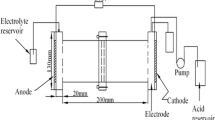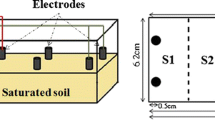Abstract
Optimizing process parameters that affect the remediation time and power consumption can improve the treatment efficiency of the electrokinetic remediation as well as determine the cost of a remediation action. Lab-scale electrokinetic remediation of Pb-contaminated soils was investigated for the effect of complexant ethylenediaminetetraacetic acid (EDTA) and acetic acid and approaching anode on the removal efficiency of Pb. When EDTA was added to the catholyte, EDTA dissolved insoluble Pb in soils to form soluble Pb–EDTA complexes, increasing Pb mobility and accordingly removal efficiency. The removal efficiency was enhanced from 47.8 to 61.5 % when the EDTA concentration was increased from 0.1 to 0.2 M, showing that EDTA played an important role in remediation. And the migration rate of Pb was increased to 72.3 % when both EDTA and acetic acid were used in the catholyte. The “approaching anode electrokinetic remediation” process in the presence of both EDTA and acetic acid had a higher Pb-removal efficiency with an average efficiency of 83.8 %. The efficiency of electrokinetic remediation was closely related to Pb speciation. Exchangeable and carbonate-bounded Pb were likely the forms which could be removed. All results indicate that the approaching anode method in the presence of EDTA and acetic acid is an advisable choice for electrokinetic remediation of Pb-contaminated soil.







Similar content being viewed by others
References
Acar YB, Alshawabkeh AN (1993) Principles of electrokinetic remediation. Environ Sci Technol 27:2638–2647
Acar YB, Alshawabkeh AN (1996) Electrokinetic remediation. I: pilot-scale tests with lead spiked kaolinite. J Geotech Geoenviron Eng ASCE 122:173–185
Amrate S, Akretche DE, Innocent C (2005) Removal of Pb from a calcareous soil during EDTA-enhanced electrokinetic extraction. Sci Total Environ 349:56–66
Ashraf Z, Krishna R (2008) Transient behavior of heavy metals in soils during electrokinetic remediation. Chemosphere 71:860–871
Chen XJ, Shen ZM, Lei YM, Ju BX, Wang WH (2006) Enhanced electrokinetic remediation of Cd and Pb spiked soil coupled with cation exchange membrane. Aust J Soil Res 44:523–529
Giannis A, Gidarakos E (2005) Washing enhanced electrokinetic remediation for removal cadmium from real contaminated soil. J Hazard Mater 123:165–175
Giannis A, Gidarakos E, Skouta A (2008) Transport of cadmium and assessment of phytotoxicity after electrokinetic remediation. J Environ Manag 86:535–544
Hansen HK, Ottosen LM, Kliem BK, Villumsen A (1997) Electrodialytic remediation of soils polluted with Cu, Cr, Hg, Pb and Zn. J Chem Technol Biotechnol 70:67–73
Hicks PE, Tondorf S (1994) Electrorestoration of metal contaminated soils. Environ Sci Technol 28:2203–2210
Kedziorek MAM, Bourg ACM (2000) Solubilization of lead and cadmium during the percolation of EDTA through a soil polluted by smelting activities. J Contam Hydrol 40:381–392
Kim SO, Kim KW, Stuben D (2002) Evaluation of electrokinetic removal of heavy metals from tailing soils. J Environ Eng 128:705–715
Kim C, Lee Y, Ong SK (2003) Factors affecting EDTA extraction of lead from lead-contaminated soils. Chemosphere 51:845–853
Kimura T, Takase K, Tanaka S (2007) Concentration of copper and a copper-EDTA complex at the pH junction formed in soil by an electrokinetic remediation process. J Hazard Mater 143:668–672
Lageman R (1993) Electroreclamation: application in the Netherlands. Environ Sci Technol 27:2648–2650
Lageman R, Pool W, Seffinga G (1989) Electro-reclamation: theory and practice. Chem Ind 18:585–590
Li G, Guo SH, Li SC, Zhang LY, Wang SS (2012) Comparison of approaching and fixed anodes for avoiding the ‘focusing’ effect during electrokinetic remediation of chromium-contaminated soil. Chem Eng J 203:231–238
Li Z, Neretnieks I, Yu JW (1997) Removal of Cu(II) and Cr(III) from naturally contaminated loam by electromigration. Journal of Environmental Science and Health. Part A 32: 1293
Lo IMC, Yang XY (1999) EDTA extraction of heavy metals from different soil fractions and synthetic soils. Water Air Soil Pollut 109:219–236
Nogueira MG, Pazos M, Sanroman MA, Cameselle C (2007) Improving on electrokinetic remediation in spiked Mn kaolinite by addition of complexing agents. Electrochim Acta 52:3349–3354
Probstein RF, Hicks RE (1993) Removal of contaminants from soils by electric fields. Science 260:498–503
Reddy KR, Shirani AB (1997) Electrokinetic remediation of metal contaminated glacial tills. Geotech Geol Eng 15:3–29
Reddy KR, Xu CY, Chinthamreddy S (2001) Assessment of electrokinetic removal of heavy metals from soils by sequential extraction analysis. J Hazard Mater 84:279–296
Reddy KR, Chinthamreddy S (2003) Sequentially enhanced electrokinetic remediation of heavy metals in low buffering clayey soils. J Geotech Geoenviron 129:263–277
Shen ZM, Chen XJ, Jia JP, Qu LY, Wang WH (2007) Comparison of electrokinetic soil remediation methods using one fixed anode and approaching anodes. Environ Pollut 150:193–199
Shenbagavalli S, Mahimairaja S (2010) Electrokinetic kinetic remediation of contaminated habitats. Afr J Environ Sci Technol 4:930–935
Sparks DL, Page AL, Helmke PA (1996) Methods of Soil Analysis. Part 3: Chemical Methods (Soil Science Society of America Book Series, No. 5). American Society of Agronomy-Soil Science Society of America.
Suer P, Gitye K, Allard B (2003) Speciation and transport of heavy metals and macroelements during electroremediation. Environ Sci Technol 37:177–181
Suer P, Lifvergren T (2003) Mercury-contaminated soil remediation by iodide and electroreclamation. J Environ Eng 129:441–446
Tessier A, Campbell PGC, Bisson M (1979) Sequential extraction procedure for the speciation of particulate trace metals. Anal Chem 51:844–851
Virkutyte J, Sillanpaa M, Latostenmaa P (2002) Electrokinetic soil remediation—critical overview. Sci Total Environ 289:97–121
Virkutyte J, Hullebusch E, Sillanpaa M, Lens P (2005) Copper and trace element fractionation in electrokinetically treated methanogenic anaerobic granular sludge. Environ Pollut 138:517–528
Wong JS, Hicks RE, Probsteini RF (1997) EDTA-enhanced electroremediation of metal contaminated soils. J Hazard Mater 55:61–80
Yeung AT, Hsu C, Menon RM (1996) EDTA-enhanced electrokinetic extraction of lead. J Geotech Geoenviron 122:666–673
Zhou DM, Deng CF, Cang L (2004) Electrokinetic remediation of a Cu contaminated red soil by conditioning catholyte pH with different enhancing chemical reagents. Chemosphere 56:265–273
Acknowledgments
This study was supported by grants from the National Special Project on Water Pollution Control and Management (no. 2012ZX07503-002). Prof. Mengqiang Zhu from the University of Wyoming (USA) is appreciated for his comments during the manuscript preparation.
Author information
Authors and Affiliations
Corresponding author
Additional information
Responsible editor: Zhihong Xu
Rights and permissions
About this article
Cite this article
Zhang, T., Zou, H., Ji, M. et al. Enhanced electrokinetic remediation of lead-contaminated soil by complexing agents and approaching anodes. Environ Sci Pollut Res 21, 3126–3133 (2014). https://doi.org/10.1007/s11356-013-2274-9
Received:
Accepted:
Published:
Issue Date:
DOI: https://doi.org/10.1007/s11356-013-2274-9




